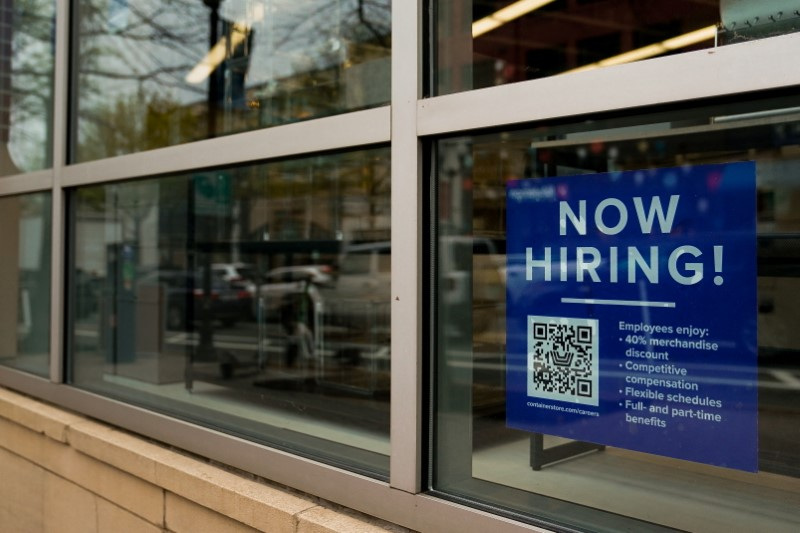US labor market holding steady; inflation trending lower
2024.09.12 13:13
By Lucia Mutikani
WASHINGTON (Reuters) – The number of Americans filing new applications for unemployment benefits increased marginally last week, suggesting that layoffs remained low even as the labor market is slowing.
Other data from the Labor Department on Thursday showed producer prices rising slightly more than expected in August amid a rebound in the cost of services. The combination of a fairly stable labor market and still-high inflation further diminished the chances of the Federal Reserve cutting interest rates by 50 basis points next Wednesday, when the U.S. central bank is expected to start its long-awaited easing cycle.
The reports followed data this month showing the unemployment rate retreated in August from a near three-year high touched in July and underlying inflation indicating some stickiness last month. Financial markets have slashed the odds of a half-point rate reduction to less than 15%.
“Producer prices are not too hot and the employment markets are not deteriorating too much either, so there is probably no need for Fed officials to surprise the markets with a bigger- than-expected 50 basis points rate cut next week,” said Christopher Rupkey, chief economist at FWDBONDS.
Initial claims for state unemployment benefits rose 2,000 to a seasonally adjusted 230,000 for the week ended Sept. 7. Economists polled by Reuters had forecast 230,000 claims for the latest week. Last week’s data included the Labor Day holiday.
Claims tend to be volatile around public holidays. They have, however, been little changed since dropping from an 11-month high of 250,000 in late July.
Unadjusted claims decreased 12,968 to 177,663 last week, led by substantial declines in California, Georgia, Michigan, Ohio and New York. No state reported increases in claims above 1,000.
The slowdown in the labor market is being driven by businesses scaling back on hiring as higher borrowing costs curb demand throughout the economy. Government data last week showed nonfarm payrolls increasing by less than expected in August but the unemployment rate falling to 4.2% from 4.3% in July.
Financial markets saw a roughly 13% probability of a 50 basis points rate cut at the Fed’s Sept. 17-18 policy meeting, CME Group’s (NASDAQ:) FedWatch Tool showed. The odds of a 25 basis point rate reduction are at about 87%.
The central bank has maintained its benchmark overnight interest rate in the current 5.25%-5.50% range for a year, having raised it by 525 basis points in 2022 and 2023.
Stocks on Wall Street were mixed. The dollar fell against the euro. The European Central Bank cut interest rates on Thursday, but offered few clues on its next move. U.S. Treasury yields were little changed.
SERVICES PRICES REBOUND
The number of people receiving benefits after an initial week of aid, a proxy for hiring, increased 5,000 to a seasonally adjusted 1.850 million during the week ending Aug. 31, the claims report showed. The so-called continuing claims could decrease in the coming weeks after schools in Minnesota reopened for the new school year in September.
Non-teaching staff in the state are allowed to file for unemployment benefits during the summer school holidays, to which economists attributed the surge in continuing claims in July to levels last seen in late 2021.
The drop in continuing claims through much of August is consistent with the decline in the unemployment rate last month.
With the labor market cooling, the threat of inflation heating up is minimal. A separate report from the Labor Department showed the producer price index for final demand rose 0.2% in August. Data for July was revised lower to show the PPI being unchanged instead of edging up 0.1% as previously reported. Economists had forecast the PPI gaining 0.1% last month.
In the 12 months through August, the PPI increased 1.7%. That was the smallest rise in six months and followed a 2.1% advance in July.
A 0.4% increase in services accounted for the rise in the PPI in August. Services, which dropped 0.3% in July, were last month boosted by a 4.8% surge in the prices of hotel and motel rooms. The cost of doctor consultations was unchanged, but hospital outpatient care increased 0.2%. Hospital inpatient care costs were unchanged.
Prices for airline fares fell 0.8%. Portfolio management fees were unchanged. Trade services, which measure changes in margins received by wholesalers and retailers, rose 0.6%, showing that businesses still have pricing power even as consumers are pushing back against higher prices.
Portfolio management fees, hotel and motel accommodation and airline fares are among components that go into the calculation of the personal consumption expenditures (PCE) price indexes, the inflation measures tracked by the Fed for its 2% target.
Wholesale goods prices were unchanged in August after rising 0.6% in July. Energy prices dropped 0.9%. Food prices gained 0.1%. Core goods prices climbed 0.2% after a similar advance in July. The narrower measure of PPI, which strips out food, energy and trade, rose 0.3%, matching July’s gain. The so-called core PPI increased 3.3% year-on-year after climbing 3.2% in July.
Based on the CPI and PPI data, economists’ estimates for the PCE price index, excluding the volatile food and energy components, ranged from an increase of 0.14% to 0.18% in August. Core PCE inflation rose 0.2% in July.

Core inflation is forecast to have advanced 2.7% year-on-year in August after rising 2.6% in July. The anticipated rise in annual core inflation would be the result of last year’s low readings dropping out of the calculation.
“The six-month annualized run rate, however, which is something Fed officials have referenced in the past, would cool to 2.3% from 2.6% in July, while the three-month annualized run rate would remain below 2%,” said Michael Hanson, an economist at J.P. Morgan.








